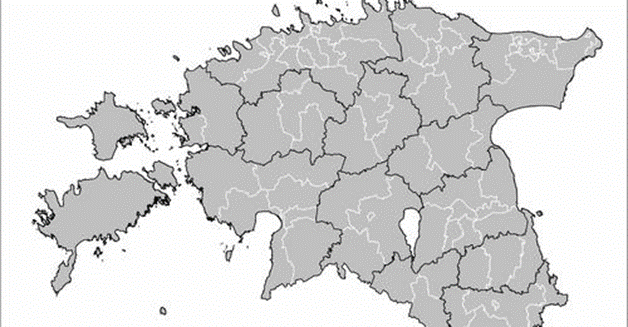- Previous mergers of local governments have demonstrated that better and more accessible services are provided with joined forces and the competitiveness of the region improves.
- Pursuant to law, a local government must guarantee compulsory basic services for its residence, but this cannot always be done if the present fragmented administrative arrangement continues.
- Only a capable local government can balance public authority and be an equal partner to the state and businesses.
Mergers of Local Authorities
Government of the Republic has encouraged and promoted the voluntary process of merging municipalities throughout recent decades to establish municipalities with greater territory and number of inhabitants, nevertheless it has not had significant influence to the local government system as a whole.
The Government of the Republic appointed to office in 2015 was the first one to agree upon implementing administrative-territorial reform of local authorities during 2017 elections. The purpose of administrative reform was to support the increase of the capacity of local governments in case of offering high quality public services, using regional prerequisites for development, increasing competitiveness, and ensuring a more consistent regional development.
Administrative Reform Act was passed in June 2016 to implement the reform and alter the administrative-territorial organization of cities and rural municipalities.
According to the law local authorities must be able to independently organize and manage local life and perform functions arising from law. Administrative Reform Act stipulated that in order for local authorities to be able to ensure professional capability necessary for organizing functions arising from law and provide quality public services to all the residents of a local government in accordance with the purpose of administrative reform all local governments must have at least 5,000 residents (criterion for the minimum size of a local government).
Local governments which did not meet the criterion for the minimum size of a local government had to submit a proposal for the alteration of administrative-territorial organization for the deadline set in law (1.01.2018). Law granted the Government of the Republic with the right to initiate the alteration of administrative-territorial organization of those local governments that did not meet the criterion or failed to submit the proposal on their own (15.02. 2017 at the latest).
Financial motivation for voluntary amalgamations were increased for the reform: voluntary amalgamation grant was doubled to 100€ per inhabitant (with the minimum amount of 300 000€ and maximum amount of 800 000€ per municipality involved in a merger). Additional grant of 500 000€ was established for fulfilling the recommended criteria of 11 000 inhabitants 500 000 €.
Additionally, compensation for former mayor and council chairman was doubled (one-year salary) and guarantee set in law for not decreasing state grants for the next 8 years due to amalgamations (i.e. if the size of the grant allocated from the state budget in the year following the year of the merger is smaller than it would have been individually, the decrease in the grant caused by the merger would be compensated for the period of 8 years).
Before the Administrative Reform Act was passed mergers of local authorities were regulated by the Territory of Estonia Administrative Division Act and Promotion of Local Government Merger Act.
There were state organized merger consultants who provided support for the local authorities involved in the merger process.
Main arguments for supporting municipal mergers is that they enable:
- to formalize administratively the long-term cooperation already in place;
- coordinated development the whole region;
- better ability to apply for European Union project support for major development and in investment projects in the entire region for a balanced and coordinated development;
- offer residents better services and hire more employees and officials with higher competence;
- increase the administrative capacity of the local authority, which will ensure the specialization of the officials and the rise in the quality of public services;
- to improve and intensify the public transport traffic, etc.
Additional information:
Territory of Estonia Administrative Division Act
Promotion of Local Government Merger Act
Administrative reform blog (in Estonian) , Collection of articles: Administrative reform 2017 in Estonia
Results of Local Government reform
As a result of the local government administrative-territorial reform (LG ATR) the number of municipalities decreased from 213 to 79.
Additional information
New legal opportunities for inter-municipal co-operation
During the reform legislation regarding the municipal co-operation and associations of local government was amended.
Regulation of joint agencies and joint administrative agencies was established in Local Government Organisation Act in order to allow local governments to cooperate in implementing tasks with public authority (e.g. supervision, managing joint school service area (administration and service provision compared to joint-school (service provision) which was already legally possible to establish). Joint administrative agency or joint agency is formed for the performance of joint functions based on a contract under public law. The latter also stipulates the regulation joint agency is governed by (generally the regulation of a local authority of its location).
Regulation of regional associations of local authorities was established in addition to the county associations of local authorities existing currently. The latter was amended and a possibility to form a joint association for two or more counties was added.
Some new joint tasks were also assigned also local governments from county governments by law. These included:
- planning the development of the county (i.e. composing county development plans as a part of the state strategic planning);
- organizing regional public transport (via jointly established public transport centers);
- coordination of regional health promotion, security councils and cultural cooperation.
Local authorities may decide the form of the co-operation for these tasks (except for the public transport), assigning it either to a (1) county or regional association of local authorities, (2) to one of the local authorities on the basis of a co-operation agreement or (3) to another co-operation body of local authorities (joint agency).
Last updated: 27.02.2021




